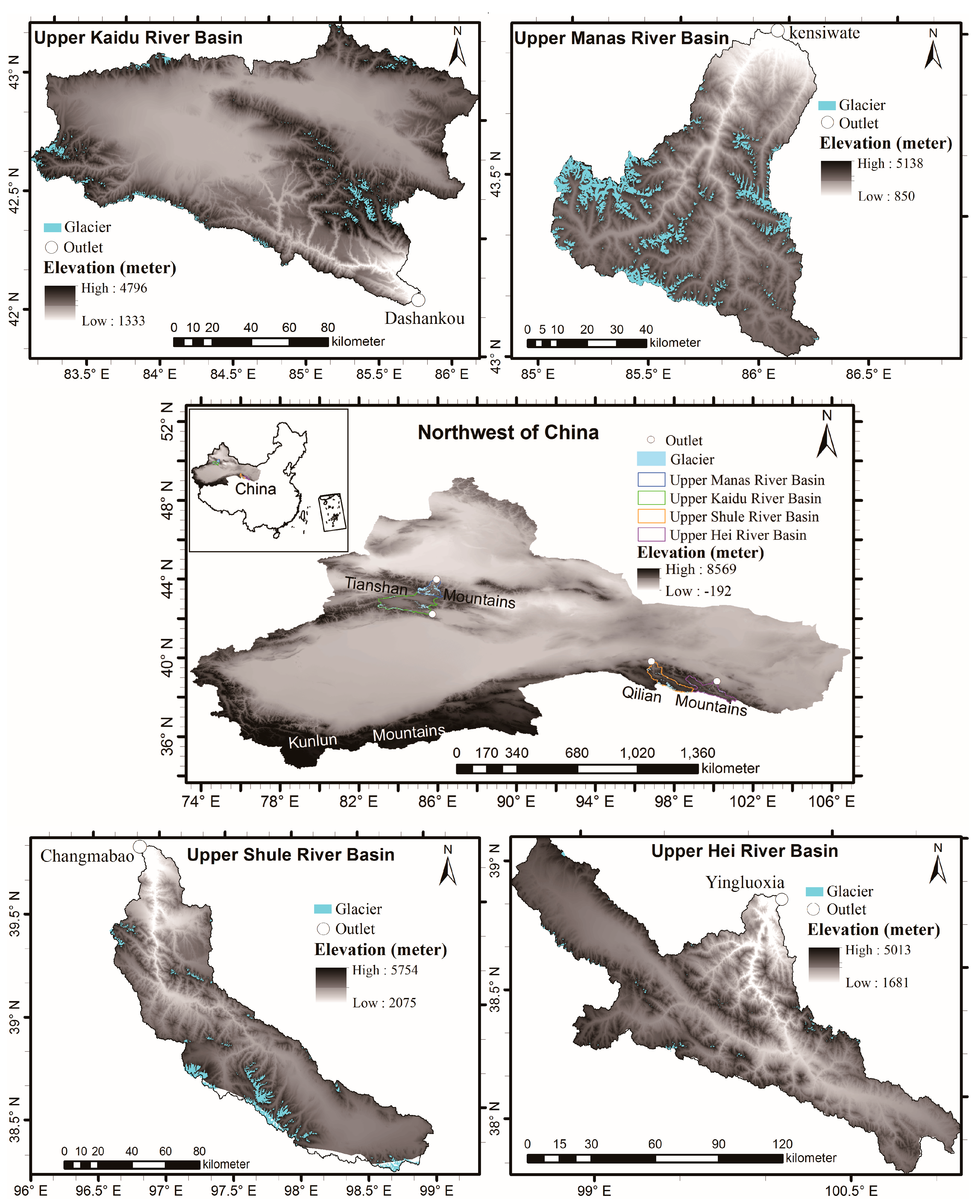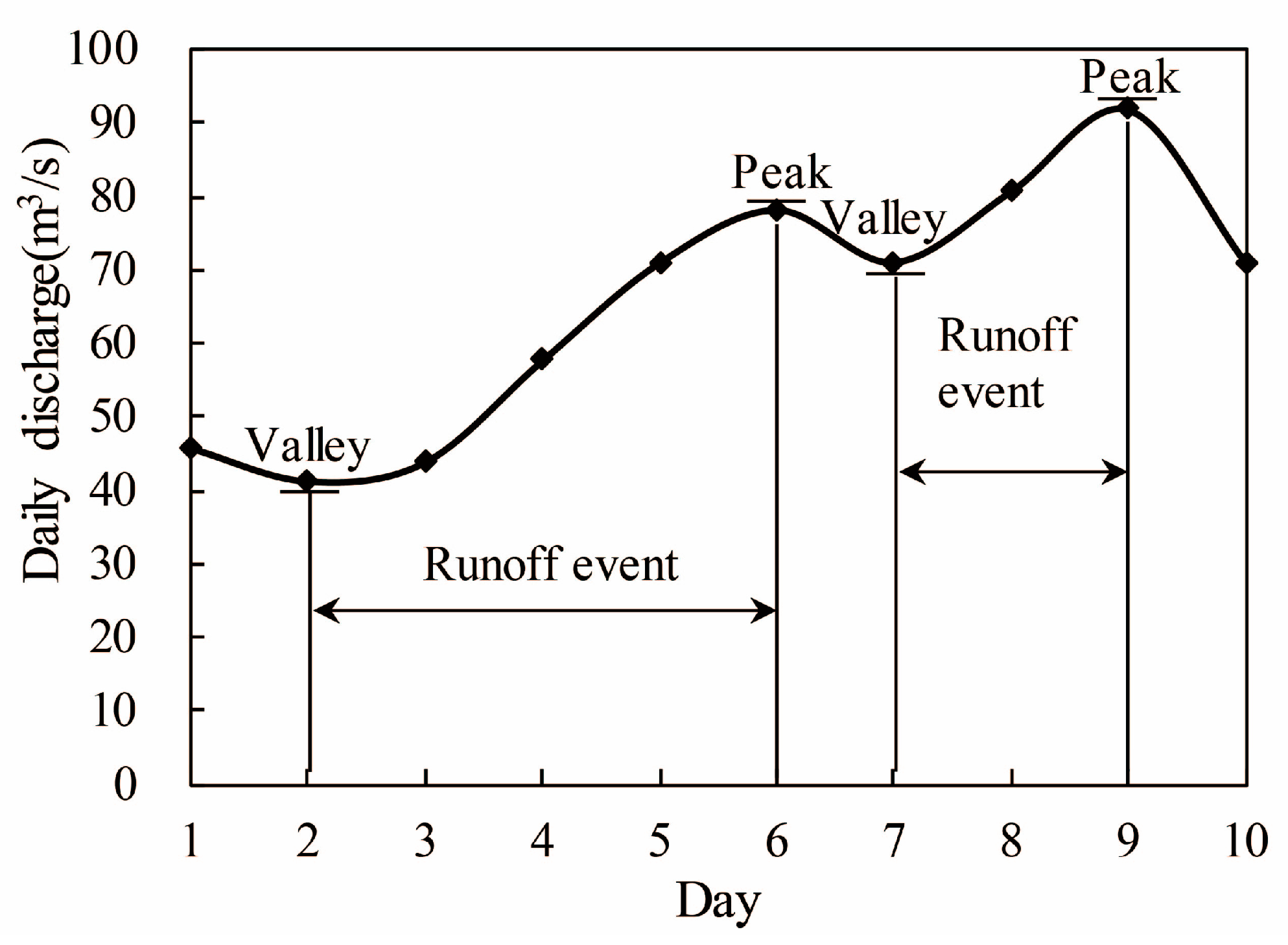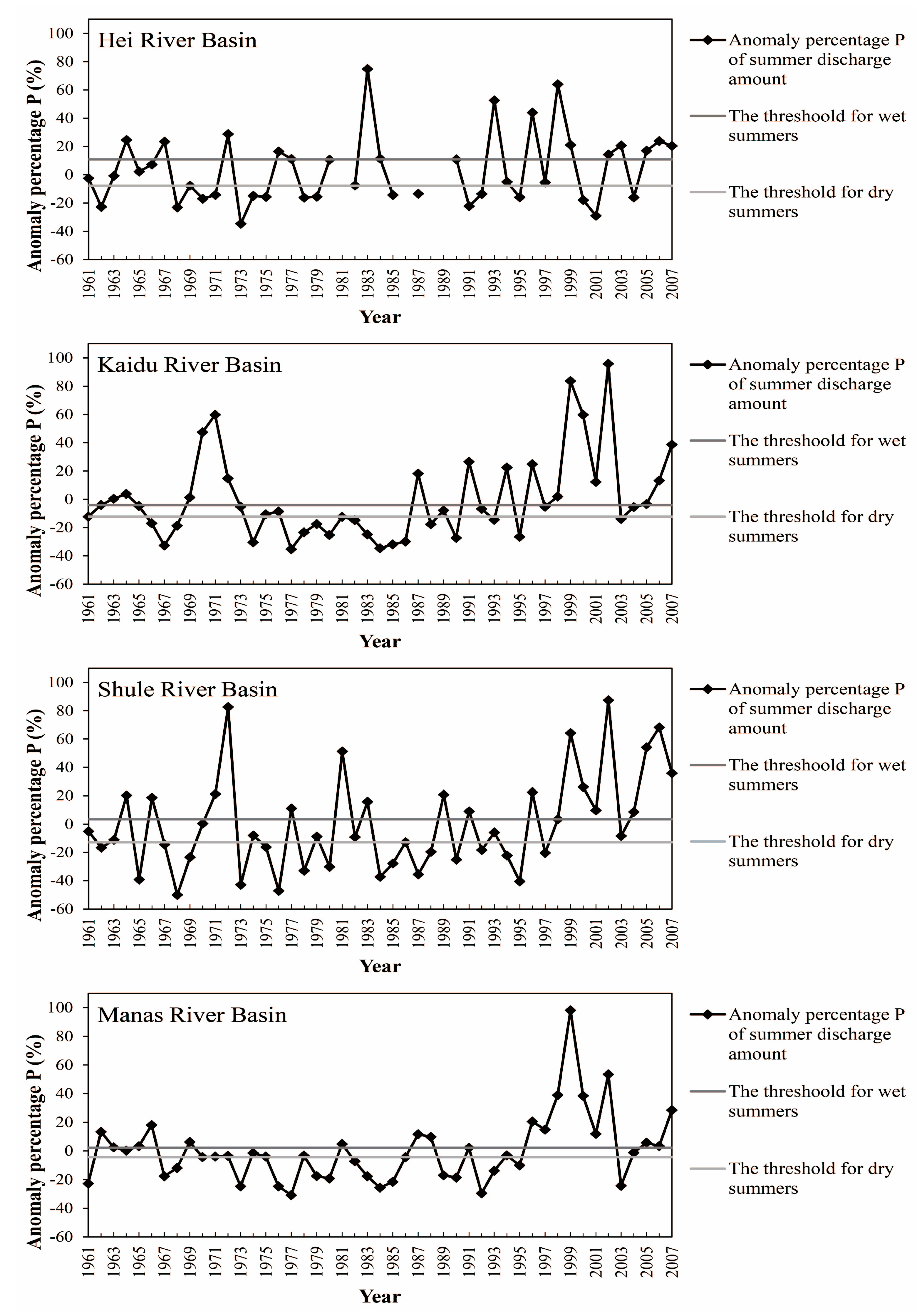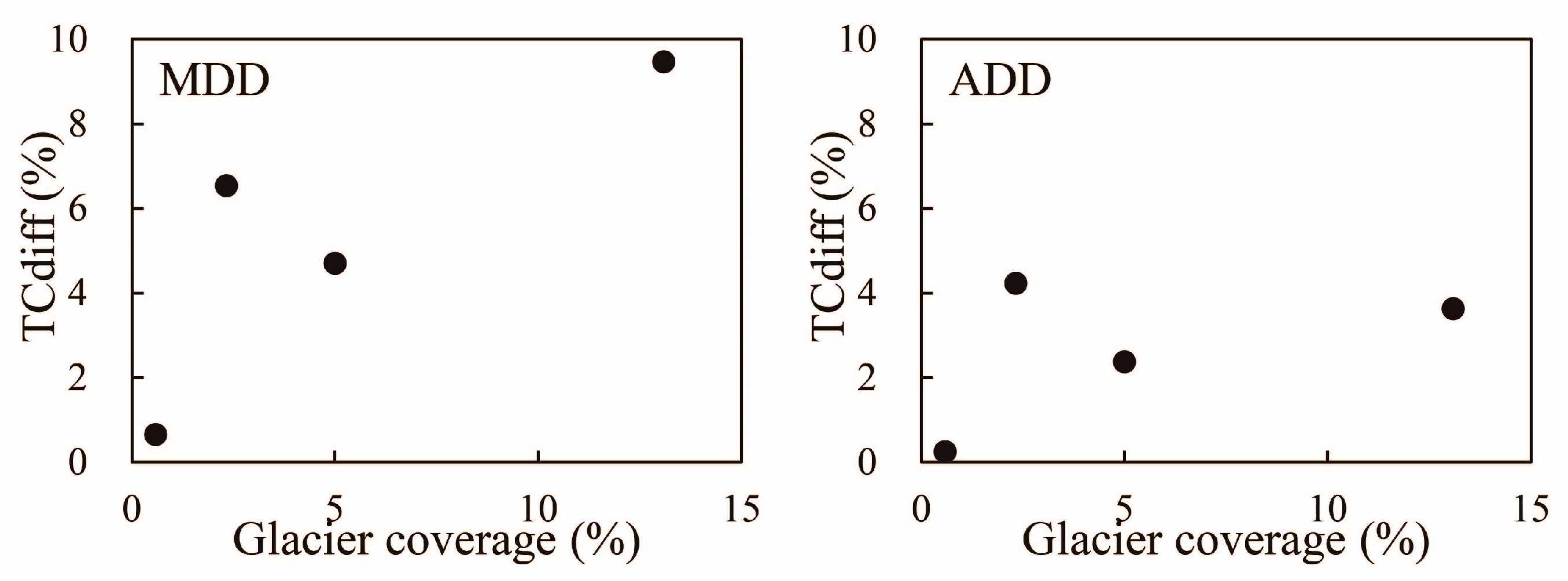1. Introduction
Global climate warming and its consequences have been discussed for years in the scientific literature and mass media, and have become the focus of attention of the scientific community [
1,
2]. The Intergovernmental Panel on Climate Change (IPCC) has concluded that global climate warming is mainly characterized by significant air temperature increases [
3]. It can increase moisture content in the atmosphere which favors stronger precipitation events and consequently increases the risk of flooding [
4,
5]. Therefore, global climate warming could induce extreme weather events and extreme hydrological events characterized by extreme runoff, resulting in the increased risk of water management.
The northwest arid region (NAR) of China is a region which is sensitive to global climate warming on the planet [
6]. The frequency and intensity of extreme precipitation and temperature events of this region have increased [
7,
8,
9], and consequently, extreme hydrological events such as hailstorms, floods (rainstorm floods, snowmelt floods, icicle floods, and glacier lake outburst floods), and landslides and so on could easily occur in this region due to the fragile ecological environment [
10]. Therefore, for disaster prevention and mitigation, it is important to study the relationships between extreme runoff events and extreme weather events in the NAR. However, most of the previous studies focused on the relationships of runoff with annual or seasonal precipitation and temperature variables [
11,
12,
13], and the relationships between extreme runoff events and extreme weather events have not been studied yet.
Moreover, the most common methods applied to define extreme runoff indices in previous studies are annual maximum (AM) and peak over thresholds (POT) [
14,
15]. AM method can find the maximum daily discharge in one year. POT method can find more daily discharge peaks than AM method in one year. However, the quantitative relationships between these daily discharge peaks, which are determined by AM and POT methods, and their associated precipitation and temperature events could not be obtained because of the difficulty of discovering which precipitation and temperature events lead to these daily discharge peaks. Thus, it is necessary to define extreme runoff indices using another method which can identify their associated precipitation and temperature events. As extreme runoff events are a few cases of runoff events, to overcome the drawback of a lack sufficient samples for extreme runoff events, the relationships between runoff events and their associated precipitation and temperature events should be understood first.
The NAR is located in a cold region, snow cover and glaciers exist in the mountainous area of this region (
Figure 1). Thus, this region experiences snowmelt water and glacial melt water floods in addition to rainstorm floods [
16,
17,
18]. In basins with snow cover, snowmelt water from April to June is an important source of runoff besides rainfall [
19,
20,
21,
22]. Snow melting is controlled by previous accumulated snow volume and air temperature during the snow melting period [
23,
24]. In basins with glaciers, glacial melt water contributes most of the runoff in the months of July and August besides rainfall [
19,
20,
25]. Glacier melting is dominated by air temperature and the relationship between runoff and air temperature is stronger with the increase of glacier coverage [
26,
27]. Therefore, it can be concluded that runoff has a complicated relationship with precipitation and temperature. Additionally, because glacier coverage and snow volume are different among basins in this region, the runoff of different basins has different relationships with precipitation and temperature on a monthly scale. Therefore, it is necessary to reveal how precipitation and temperature dominate the runoff of a particular basin on specific time scale in the NAR.
As July and August are the main months which experience more precipitation and higher air temperature in the NAR, runoff in these months contributes more to annual runoff than the other months in this region [
28], and they are high risk months for floods. However, the quantitative relationships of runoff events with precipitation and temperature in these months for the basins of this region have not been studied yet. The impacts of different glacier coverage on runoff events have not been discussed yet. Thus, to provide scientific knowledge of water resource management for basins in the NAR, a typical cold region in the world, this paper aims to: (1) define runoff indices and precipitation and temperature indices which might cause these runoff indices; (2) reveal the quantitative relationships of runoff indices with their related precipitation and temperature indices in the months of July and August by linear regression equations based on typical basins in the NAR with different glacier coverage; (3) discuss the regulation of different glacier coverage on runoff.
4. Discussion
In this study, a runoff event is from the valley to the next peak in the time series of daily average discharge (
Figure 2). Runoff events in the time series of daily average discharge were extracted for the outlets of selected basins in the NAR. Two runoff indices—MDD and ADD—were defined and calculated for each runoff event. MDD is the difference of daily average discharge between the peak and the valley in each runoff event and ADD is the accumulated daily direct discharges during each runoff event. Daily direct discharge is the difference between a certain daily discharge and the valley discharge in a runoff event (
Table 2). In the definition of these two runoff indices, the valley discharge was subtracted from daily discharges in each runoff event. Precipitation and temperature events occurring during these runoff events can be the main cause for the increase in daily average discharges of these runoff events. Thus, the runoff events defined in this study are independent.
Areal average daily precipitation and temperature were determined for each selected basin by using the grid datasets of daily precipitation and temperature and the boundaries of these selected basins. Subsequently, some precipitation and temperature indices which may contribute to the increase of daily average discharges during a runoff event were defined based on the obtained areal average daily precipitation and temperature. These precipitation indices are MDP, DPP, IP, APA, and DP (
Table 3). MDP, DPP, and IP can characterize the intensity of the precipitation events during a runoff event; APA and DP the amount and days, respectively. The temperature indices are MnT, MT, and AT (
Table 3). MnT and MT can reflect the average and maximum intensity of the temperature event during a runoff event; AT can reflect the days and amount. These precipitation and temperature indices can represent the common characteristics of precipitation and temperature events: intensity, frequency, and amount. Thus, these indices can be used to study the relationships between the runoff indices and the related precipitation and temperature indices.
In this study, because the precipitation and temperature indices were calculated using the areal average daily precipitation and temperature, the areal average weather events during a runoff event can be regarded as the main cause of this runoff event. The weather event which can trigger runoff events and occur before these runoff events were not considered in this study because the defined precipitation and temperature indices during the associated runoff events have explained the variability of these runoff events quite well. The linear regression equations on the relationships between the runoff indices and their associated precipitation and temperature indices were built (
Table 5), and the coefficients in these equations were obtained (
Table 7). Because the time series of these runoff, precipitation, and temperature indices were detrended, the other factors which can have effects on the variations in these indices were excluded, and only the relationship between the variations in the runoff indices and the precipitation and temperature indices were built. Therefore, these runoff indices during a few days could be explained by their associated precipitation and temperature indices in this study.
Consequently, the precipitation and temperature indices during a few days on a basin scale can be used to explain the runoff indices in the same period by their standardized coefficients in the linear regression equations. If the values of precipitation and temperature indices are very high on a few days, there will likely be large MDD and ADD on these days at the outlets of basins. The water level in the channel and the total accumulated daily average discharge in the reservoir at the outlet of a basin during these days might increase largely. This study could provide an example for basins which are in cold regions with glaciers and snow cover to explain runoff if the areal average daily precipitation and temperature datasets of these basins can be determined. This could provide scientific knowledge to manage water resources and prevent disasters.
Because the glacier melt water mainly contributes to runoff in the months of July and August which are regarded as summer in this study, the impacts of glacier coverage on runoff could be found if the relationship between runoff and temperature in these months is obtained. The contributions of temperature indices to runoff indices for selected basins increased during dry summers compared with those during wet summers. This might be because glacier melting water contributes more to runoff in hot and dry spells than in cold and wet spells [
27,
30]. The results of plotted TCdiff against glacier coverage (
Figure 4) infer that with the increase of glacier coverage, the regulation of glaciers on runoff become stronger. Thus, the runoff variations during a year in basins which have high glacier coverage will likely be smaller than those in basins which have low glacier coverage due to the glacier’s effect of reducing peaks and filling valleys in the time series of daily discharge. These results are in agreement with the work of Ding et al. [
31,
32].
The regulation of glaciers on the runoff indices—MDD and ADD—are stronger in Kaidu River Basin than in Shule River Basin (
Figure 4), though the glacier coverage of Kaidu River Basin is much smaller than that of Shule River Basin. The reason might be that the areal average daily temperature of summer is much higher in Kaidu River Basin than in Shule River Basin (
Table 10). Thus, when only the relationships between TCdiff and glacier coverage are going to be discussed, basins with similar areal average daily temperature in summer should be selected since high summer temperature can enlarge the effect of glacier coverage on runoff [
19]. Though only a few basins with glacier coverage were analyzed in this study due to lack of daily discharge data, this study is still a good case to reveal the regulation of glacier coverage on runoff.
5. Conclusions
In this study, two runoff indices—MDD and ADD—were defined and calculated for each runoff event in the time series of daily average discharge of selected upper basins of the Hei River, Shule River, Kaidu River, and Manas River during 1961–2007. As the start and end date of each runoff event can be found based on the definition of runoff event in this study, the precipitation and temperature events could be identified during these runoff events. Eight precipitation and temperature indices which might effect on runoff indices were defined and calculated for their associated runoff events. The linear regression relationships between these runoff indices and their associated precipitation and temperature indices were obtained for selected basins during wet and dry summers, respectively. Moreover, the regulations of glacier coverage on runoff were discussed according to the relationships between TCdiff and glacier coverage of these selected basins for both of the runoff indices. The following important conclusions were obtained.
Firstly, because glaciers and snow cover melting are controlled by temperature, the characteristics of runoff events in basins which lie in cold regions can be well explained by the variables of precipitation and temperature events during these runoff events. The linear regression equations on the relationship between runoff indices and their associated precipitation and temperature indices provide a possibility to explain the runoff events using precipitation and temperature datasets, which holds importance for basins in cold regions to be able to manage their water resources and prevent disasters.
Secondly, the increase of TCdiff with the increase of glacier coverage infers that the regulation of glaciers on runoff is more significant in basins which have larger glacier coverage. Thus, the variations of runoff during a year decrease in glacierized basins compared with those without glaciers or with small glacier coverage.










